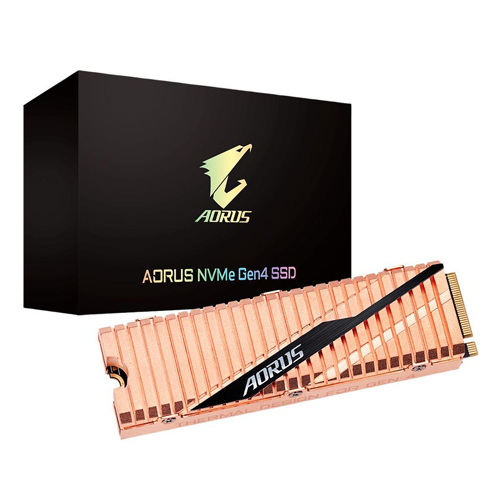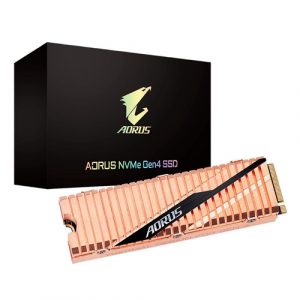GIGABYTE AORUS 2TB M.2 2280 PCI-Express 4.0 x4 3D TLC NVMe Gen4 SSD GP-ASM2NE6200TTTD
Overview :
World First PCIe 4.0×4 Controller
The World First PCIe 4.0×4 Controller, Phison PS5016-E16 controller, made by 28nm manufacturing technology. The advanced fabrication process ensures PS5016-E16 has enough compute power for ECC processing when adopting the latest 3D TLC NAND flash. PS5016-E16 also features eight NAND channels with 32 CE targets, DDR4 DRAM caching, and a PCIe 4.0×4 interface. As for features, the chip supports the NVMe 1.3 protocol, LDPC error correction, and Wear Leveling, Over-Provision technologies to improve reliability and durability of SSDs.
- PCIe 4.0×4, NVMe 1.3 Interface
- DDR4 DRAM cache
- 8 CH with 32 CEs
- Phison 4th Gen LDPC & RAID ECC
- Support Pyrite
- Heat spreader for controller
With the new PCIe 4.0 controller, AORUS NVMe Gen 4 SSD delivers blazing speeds: up to 5,000 MB/s for sequential read, and up to 4,400MB/s sequential write. Sequential Read performance of PCIe 4.0 SSDs is up to 40% faster than PCIe 3.0 SSDs. Get ready to enter the next generation of computing with faster and smoother, gaming, streaming, and graphics intensive rendering.
Full Body Copper Thermal Solution for Outstanding PCIe 4.0 SSD Performance
The Full Body Copper Heatsink takes into account the heat transfer from key components on both the front and back of the device, the controller and NAND Flash. Full copper heatsinks have 69% higher heat transfer capacity compared to aluminum heatsinks giving AORUS NVMe Gen4 SSD the best heat dissipation for read/write performance.
Efficient Copper Heat Spreader Design
Compared with a plated M.2 heat spreader, new efficient copper heat spreaders with 27 fins add more surface area which improve thermal transfer from heating sources to obtain thermal balance sooner. Moreover, Optimized fin array design does great heat exchange with any direction of air flow. Both unique design make sure key components of PCIe 4.0 SSD to keep suitable working temperature under ultra high transfer rate.
Why is keeping an SSDs at lower temperatures so important?
- Higher working temperature may cause data loss. The degradation factor of data loss could be a hundred times higher.
- With Full Body Copper Heat Spreaders, the AORUS NVMe Gen 4 SSD can operate at lower working temperatures to improve data storage reliability. Furthermore, SSDs can deliver extreme performance for longer periods.
SSD Tool Box
The newly updated SSD Tool Box is a software that gives users an overview of the SSD Status and various aspects such as model name, FW version, health condition and sensor temperature. Moreover, users can clear all the data with the Secure Erase function. You can download the SSD Tool Box from the link.
Specification :
| Interface | PCI-Express 4.0×4, NVMe 1.3 |
| Form Factor | M.2 2280 |
| Total Capacity | 2000GB |
| Warranty | Limited 5-years or 3600TBW |
| NAND | 3D TLC Toshiba BiCS4 |
| External DDR Cache | DDR4 2GB |
| Sequential Read speed | Up to 5000 MB/s |
| Sequential Write speed | Up to 4400 MB/s |
| Random Read IOPS | up to 750k |
| Random Write IOPS | up to 700k |
| Dimension (W x H x L) | 80.5 x 11.4 x 23.5 mm |
| Mean time between failure (MTBF) | 1.77 million hours |
| Power Consumption (Active) | Average: R : 6.5W; W : 6.6W |
| Power Consumption (Idle) | 21.1mw |
| Temperature (Operating) | 0°C to 70°C |
| Temperature (Storage) | -40°C to 85°C |




